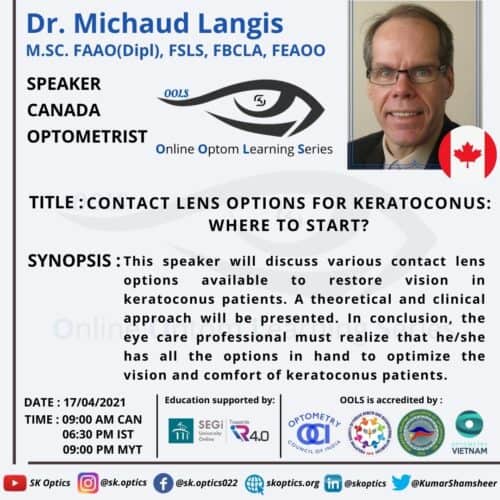
Dr. Langis Michaud, a practicing optometrist, educator and a contact lens expert begins by mentioning that nearly 1 out of 1000 patients suffer from keratoconus (KC) and that early diagnosis is the key element in treating KC.
He states that the condition is developing as early as 16 years of age. Topography is the standard of care for diagnosis but, Dr. Michaud also mentions other signs that might help in the absence of a topographer. The selection of treatment can depend on the following factors.
- Age of the subject
- Type/Shape/ power of the KC/ stage
- Corneal thickness
- Pattern of evolution
- Budget of the patient
Managing Keratoconus cases mainly involves starting with refraction (11:46). We learn about the different techniques we can use and also the importance of getting the refraction for KC patients. Once we have the right refraction and other parameters we can think about the treatment options.
We learn in detail about the following treatment options their benefits and contraindications.
- Collagen Cross Linking
- Intra-stromal rings
- Photorefractive keratectomy (PRK)
- Specialty contact lenses
- Sclerals lens
- Hybrids lens
- Gas permeables lens with piggy back
- Custom soft lens
We review a flow chart which helps determine the what type of contact lens would be best for what KC conditions.Dr. Michaud then discusses detail on how to go about fitting scleral lenses for the novice practitioner. After talking about the important parameters we talk about how to assess and optimize the scleral lens fit for KC patient by changing the following parameters
- Diameter
- Central vault
- Limbal vault
- Conjunctival support
- Edge profiles
- Over refraction
We learn about the specialty gas permeable lenses and how different types of cones can be fit with different designs. Most novice practitioners often struggle with the first lens selection and achieving the ideal fit for the different types of lenses, Dr. Michaud helps us by reviewing both those points. Lastly, the session concludes with some interesting questions from the live audience.
References
Papers
Hersh PS, Greenstein SA, Fry KL. Corneal collagen crosslinking for keratoconus and corneal ectasia: One-year results. J Cataract Refract Surg. 2011 Jan;37(1):149-60.
https://pubmed.ncbi.nlm.nih.gov/21183110/
Nattis A, Donnenfeld ED, Rosenberg E, Perry HD. Visual and keratometric outcomes of keratoconus patients after sequential corneal crosslinking and topography-guided surface ablation: Early United States experience. J Cataract Refract Surg. 2018 Aug;44(8):1003-1011.
https://pubmed.ncbi.nlm.nih.gov/30037699/
Michaud L, Breton L. Contact lens fitting post-corneal cross-linking. Cont. Lens Spectr. 2018 Mar.
https://www.clspectrum.com/issues/2018/march-2018/contact-lens-fitting-post-corneal-cross-linking
